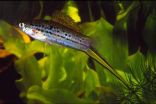(Press-News.org) NOAA's GOES-West and NASA-JAXA's Global Precipitation Measurement or GPM mission satellite helped forecasters at the National Hurricane Center determine that what was once Tropical Storm Fausto is now a remnant area of low pressure in the Eastern Pacific Ocean.
Forecaster Beven at the National Hurricane Center (NHC) noted that "satellite imagery, overnight scatterometer data, and a recent GPM satellite microwave overpass indicate that Fausto has degenerated to a trough of low pressure."
On July 9 at 1500 UTC (11 a.m. EDT) Fausto's circulation was no longer apparent on visible imagery from NOAA's GOES-West satellite. The image showed the developing low pressure area known as System 98E, located to the east of Fausto, was slightly more organized today. The GOES-West image was created at NASA/NOAA's GOES Project at NASA's Goddard Space Flight Center in Greenbelt, Md.
The National Hurricane Center issued the final advisory on Fausto at the time of the GOES-West image. At that time, Fausto's remnants were located near 11.7 north latitude and 129.5 west longitude, about 1,505 miles (2,420 km) west-southwest of the southern tip of Baja California. The maximum sustained winds were near 30 mph (45 kph) and weakening. The NHC expects winds associated with the remnants of Fausto should decrease during the next couple of days.The estimated minimum central pressure was 1007 millibars.
The remnants were moving west-northwest near 17 mph (28 kph) and are expected to continue in a general west-northwestward motion for the next several days. Over that time, they will move through an area of increasing vertical wind shear and mid-level dry air which will help them dissipate.
System 98E is located to the east of Fausto's remnants. The broad low pressure area is generating showers. It is located several hundred miles southwest of the southern tip of the Baja California Peninsula and has become better organized today. NHC noted that additional slow development is possible during the next day or so before upper-level winds become less friendly for development.
INFORMATION:
NASA, NOAA satellites help confirm Tropical Storm Fausto as a remnant low
2014-07-09
ELSE PRESS RELEASES FROM THIS DATE:
Study identifies novel genomic changes in the most common type of lung cancer
2014-07-09
Researchers from The Cancer Genome Atlas (TCGA) Research Network have identified novel mutations in a well-known cancer-causing pathway in lung adenocarcinoma, the most common subtype of lung cancer. Knowledge of these genomic changes may expand the number of possible therapeutic targets for this disease and potentially identify a greater number of patients with treatable mutations because many potent cancer drugs that target these mutations already exist.
TCGA is jointly funded and managed by the National Cancer Institute (NCI) and the National Human Genome Research ...
Study cracks how the brain processes emotions
2014-07-09
ITHACA, N.Y. – Although feelings are personal and subjective, the human brain turns them into a standard code that objectively represents emotions across different senses, situations and even people, reports a new study by Cornell University neuroscientist Adam Anderson.
"We discovered that fine-grained patterns of neural activity within the orbitofrontal cortex, an area of the brain associated with emotional processing, act as a neural code which captures an individual's subjective feeling," says Anderson, associate professor of human development in Cornell's College ...
Bacteria hijack plentiful iron supply source to flourish
2014-07-09
In an era of increasing concern about the prevalence of antibiotic-resistant illness, Case Western Reserve researchers have identified a promising new pathway to disabling disease: blocking bacteria's access to iron in the body.
The scientists showed how bacterial siderophore, a small molecule, captures iron from two abundant supply sources to fan bacterial growth — as well as how the body launches a chemical counterassault against this infection process. Their findings appear in a recent edition of The Journal of Experimental Medicine.
"Bacterial siderophore will be ...
Climate change provides good growing conditions for charcoal rot in soybeans
2014-07-09
URBANA, Ill. – With over 100 diseases that can attack soybean crops, why would charcoal rot rise to the top of the most wanted list? University of Illinois scientists cite the earth's changing climate as one reason that more research is needed on the fungus that causes charcoal rot.
Fungi may often be associated with cool, damp growing conditions but Macrophomina phaseolina, the fungus that causes charcoal rot, prefers hot and dry drought conditions.
"As the climate continues to change and we see more extremes in the weather, including hotter, drier summers, this fungus ...
Biologists link sexual selection and placenta formation
2014-07-09
RIVERSIDE, Calif. — Sexual selection refers to species' selection for traits that are attractive to the opposite sex. This special type of natural selection enhances opportunities to mate, the tail of male peacocks being an iconic example.
Biologists at the University of California, Riverside have now found that sexual selection and "placentation" — the formation of a placenta — are linked. Describing the life histories of more than 150 species of fish in the family Poeciliidae, the researchers found that species with placentas tend to have males that do not have bright ...
USF study: Amphibians can acquire resistance to deadly fungus
2014-07-09
Tampa, Fla. (July 9, 2014) – Emerging fungal pathogens pose a greater threat to biodiversity than any other parasitic group, causing population declines of amphibians, bats, corals, bees and snakes. New research from the University of South Florida published in the prestigious journal Nature reveals that amphibians can acquire behavioral or immunological resistance to a deadly chytrid fungus implicated in global amphibian population declines.
"Acquired resistance is important because it is the basis of vaccination campaigns based on 'herd immunity', where immunization ...
Fox Chase researchers recommend updating the staging criteria for breast cancer diagnoses
2014-07-09
New findings from Fox Chase Cancer Center paint a relatively optimistic picture of women's chances of surviving a subset of breast cancers that have spread to the chest wall or skin, but not beyond.
Tumors that grow into the skin, regardless of size and whether they have involved lymph nodes, are automatically classified as stage III – and called "locally advanced" tumors, suggesting that they are a relatively serious form of cancer, often with poor survival. Locally advanced breast cancers of this and other types account for five to ten percent of new breast cancer ...
MyChart use skyrocketing among cancer patients, UT Southwestern study finds
2014-07-09
DALLAS – July 9, 2014 – There has been a sharp increase in the number of cancer patients at UT Southwestern Medical Center using MyChart, the online, interactive service that allows patients to view laboratory and radiology results, communicate with their healthcare providers, schedule appointments, and renew prescriptions.
Over a six-year period, the number of patients actively using MyChart each year increased five-fold, while the number of total logins each year increased more than 10-fold, according to a study by Dr. David Gerber, Associate Professor of Internal Medicine, ...
New study finds that Adélie penguin population is on the rise
2014-07-09
A first-ever global census of Adélie penguins shows that the population is 3.79 million breeding pairs or 53 percent larger than previously estimated. Adélie penguins have long been considered a key indicator species to monitor and understand the effects of climate change and fishing in the Southern Ocean.
By using high-resolution satellite imagery, researchers from Stony Brook University and University of Minnesota have applied a new method that permits regular monitoring of Adélie penguins across their entire breeding range, and by extension the health of the Southern ...
Researchers declassify dinosaurs as being the great-great-grandparents of birds
2014-07-09
The re-examination of a sparrow-sized fossil from China challenges the commonly held belief that birds evolved from ground-dwelling theropod dinosaurs that gained the ability to fly. The birdlike fossil is actually not a dinosaur, as previously thought, but much rather the remains of a tiny tree-climbing animal that could glide, say American researchers Stephen Czerkas of the Dinosaur Museum in Blanding, Utah, and Alan Feduccia of the University of North Carolina. The study appears in Springer's Journal of Ornithology.
The fossil of the Scansoriopteryx (which means "climbing ...







